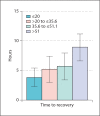Impact of sleep quality on cardiovascular outcomes in hemodialysis patients: results from the frequent hemodialysis network study
- PMID: 21474924
- PMCID: PMC3080580
- DOI: 10.1159/000326343
Impact of sleep quality on cardiovascular outcomes in hemodialysis patients: results from the frequent hemodialysis network study
Abstract
Background: Poor sleep quality is a common, persistent, and important problem to patients with end-stage renal disease (ESRD). This report examines whether sleep quality is associated with dialysis treatment factors and other modifiable clinical factors in a large group of hemodialysis (HD) patients.
Methods: Cross-sectional analyses were conducted on baseline data collected from participants in the Frequent Hemodialysis Network trials. Sleep quality was measured using the Medical Outcomes Study Sleep Problems Index II (SPI II), a 9-item measure of sleep quality with higher scores reflecting poorer sleep quality.
Results: The participants had an age of 51.2 ± 13.6 years, 61% were male, 38% were black, and 42% had diabetes. Higher pre-dialysis serum phosphorus (per 0.5 mg/ml) (OR 0.91; 95% CI 0.85, 0.96) and depression (OR 0.16; 95% CI 0.10, 0.25) were independently associated with decrements in sleep quality. There was also a difference in time to recovery from dialysis for the fourth versus the first SPI II quartile (5.1 h; p < 0.0001).
Conclusion: These findings underscore the link between sleep and daytime function and suggest that improving sleep may provide an opportunity to improve outcomes in ESRD. Whether sleep problems may be improved by reduction of serum phosphorus or treatment of depression in the HD population merits further investigation.
Copyright © 2011 S. Karger AG, Basel.
Figures



References
-
- Holley JL, Nespor S, Rault R. A comparison of reported sleep disorders in patients on chronic hemodialysis and continuous peritoneal dialysis. Am J Kidney Dis. 1992;19:156–161. - PubMed
-
- Walker S, Fine A, Kryger MH. Sleep complaints are common in a dialysis unit. Am J Kidney Dis. 1995;26:751–756. - PubMed
-
- De Vecchi A, Finazzi S, Padalino R, Santagostino T, Bottaro E, Roma E, Bossi R. Sleep disorders in peritoneal and haemodialysis patients as assessed by a self-administered questionnaire. Int J Artif Organs. 2000;23:237–242. - PubMed
-
- Hui DS, Wong TY, Ko FW, Li TS, Choy DK, Wong KK, Szeto CC, Lui SF, Li PK. Prevalence of sleep disturbances in Chinese patients with end-stage renal failure on continuous ambulatory peritoneal dialysis. Am J Kidney Dis. 2000;36:783–788. - PubMed
-
- Unruh ML, Hartunian MG, Chapman MM, Jaber BL. Sleep quality and clinical correlates in patients on maintenance dialysis. Clin Nephrol. 2003;59:280–288. - PubMed
Publication types
MeSH terms
Grants and funding
LinkOut - more resources
Full Text Sources
Medical

